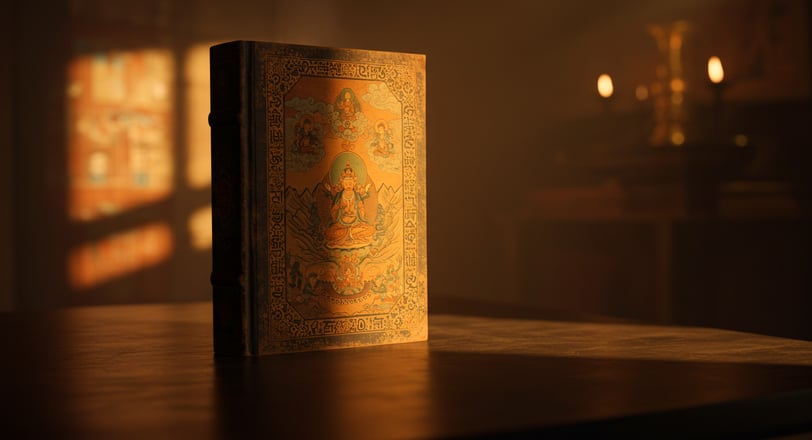The Fascinating History of the Tibetan Book of the Dead
2/8/20257 분 읽기


Introduction to the Tibetan Book of the Dead
The Tibetan Book of the Dead, known in Tibetan as Bardo Thodol, occupies a prominent position within Tibetan Buddhism, serving as a critical text for understanding the intricate processes of death and rebirth. This revered scripture is not merely a funeral guide; rather, it offers profound insights into the nature of existence, consciousness, and the transitional states individuals encounter during and after death. The Bardo Thodol is traditionally recited aloud for the benefit of the deceased, aiding them in navigating the complexities of the afterlife experience.
The text details the various stages of the "bardo," a term that refers to the intermediate state between death and rebirth, guiding the departed soul through a series of existential challenges and opportunities for liberation. It elaborates on the encounters one may face, including the manifestation of deities, visions, and inner experiences that reflect the deceased's karmic imprints. Each phase presents an opportunity for awakening, allowing the individual to achieve enlightenment or to be reborn based on their ability to recognize the nature of reality in that moment.
Origins and Authorship
The Tibetan Book of the Dead, known as "Bardo Thodol," possesses a rich and intriguing history that traces back to the 8th century. Central to its creation is the revered figure of Padmasambhava, a mystic believed to have originated from Oddiyana, a region often associated with the mythic land of Shambhala. Padmasambhava is credited with introducing Buddhism to Tibet, and his teachings laid the foundation for the rich tapestry of Tibetan spiritual practices. The narratives surrounding his life portray him as a powerful practitioner of tantra, whose insights into the nature of the mind and death significantly influenced Tibetan culture.
Traditionally, it is believed that Padmasambhava composed the Tibetan Book of the Dead in collaboration with his esteemed disciple, Yeshe Tsogyal. Yeshe Tsogyal is celebrated not only as a devoted follower but also as a significant spiritual figure in her own right. According to legend, she served as the scribe of this monumental work, recording Padmasambhava's teachings that elucidate the process of dying, the intermediate states of existence (bardo), and the journey toward enlightenment. This partnership is often highlighted as an essential aspect of the text's authorship, showcasing a dynamic exchange of wisdom and experience.
The Tibetan Book of the Dead serves as a guide for the deceased, navigating them through the bardo states post-mortem and instructing them on how to attain liberation. The text draws on a rich variety of Buddhist concepts, and its teachings reflect the profound philosophical and spiritual insights attributed to Padmasambhava. The legends encapsulated within these accounts not only reveal the complexity of the authorship but also emphasize the profound significance of the teachings for Tibetan Buddhism. These narratives continue to resonate with practitioners today, demonstrating the enduring impact of Padmasambhava and Yeshe Tsogyal on Tibetan spiritual heritage.
Cultural and Spiritual Context
The Tibetan Book of the Dead, known as Bardo Thodol, emerged during a transformative period in 8th century Tibet, shaped by the confluence of Buddhism and indigenous Tibetan beliefs. Significant cultural exchanges occurred due to the arrival of various Buddhist texts and teachings from India while local shamanistic practices coexisted, creating a unique spiritual landscape. This integration of beliefs manifested in an evolving understanding of life, death, and the afterlife. It was within this rich tapestry of traditions that the Tibetan Book of the Dead was conceived.
In Tibetan culture, the afterlife is a pivotal aspect of spiritual understanding. The belief in multiple realms of existence highlights the cyclical nature of life and death, where the experiences of each sentient being continue beyond physical death. The Tibetan perspective emphasizes that the manner in which one navigates this transitional phase—referred to as Bardo—can significantly influence the soul's next incarnation. The Book of the Dead serves as a guide for those traversing these realms, offering teachings that illuminate the nature of reality and suggest ways to attain liberation from the cycle of rebirth.
The text is not merely a funerary document but also a significant work that encapsulates the essence of Tibetan spirituality. It draws upon both the teachings of the Buddha and pre-Buddhist Tibetan philosophies, illustrating the deep interconnections between the two. The emphasis on compassion and mindfulness exemplifies Buddhism’s influence, while the rich mythological and ritualistic elements highlight the indigenous worldview. Thus, the Tibetan Book of the Dead stands as a testament to the spiritual evolution of Tibetan society, cultivating a framework for understanding existential transitions and enriching the cultural heritage of Tibet.
Structure and Themes of the Tibetan Book of the Dead
The Tibetan Book of the Dead, known as Bardo Thodol, is a profound spiritual text that intricately blends various philosophical themes and structured teachings about the process of death and rebirth. Traditionally, the text is divided into three primary sections, each focusing on different phases of the bardo experience: the moment of death, the intermediate state, and the rebirth process. This tripartite framework serves as a guide for the deceased and the living, shedding light on the intricacies of life after death.
The first section of the text addresses the moment of death, detailing how the dying individual experiences the dissolution of the physical body and encounters various mental states. This part emphasizes the importance of recognizing these experiences as illusions of the mind, drawn from deep-seated habits and karmic outcomes. It is here that the concept of karma becomes pivotal, as the accumulated actions influence the nature of one’s experiences in the bardo.
The second section delves into the intermediate state or bardo, which is a transitional phase thought to last up to 49 days. During this time, the individual's consciousness experiences vivid scenarios that reflect both attachments and aspirations from their past life. The narrative presents a variety of deities and visions, some peaceful and others wrathful, guiding the consciousness toward liberation or rebirth. Practicing mindfulness and understanding the illusory nature of these phenomena is emphasized as essential for navigating this state.
The final section focuses on the rebirth process, outlining the cyclical nature of samsara, where enlightenment becomes the ultimate goal. Here, the text articulates the significance of spiritual practice and the cultivation of wisdom to break free from the cycle of rebirth. Significantly, the themes of illusion, karma, and the pursuit of enlightenment are interwoven throughout, providing a comprehensive spiritual framework within which practitioners can understand the profound truths of existence and the afterlife.
Historical Impact and Transmission
The Tibetan Book of the Dead, or Bardo Thodol, has played a pivotal role in Tibetan culture and Buddhism since its composition in the 8th century. This text, attributed to the renowned master Padmasambhava, serves as a guide for the deceased, providing instructions on navigating the intermediate state known as Bardo, where souls transition to their next rebirth. Its profound teachings have been integral in shaping Tibetan funeral rituals, influencing not only the spiritual practices within monasteries but also the lay communities that adhere to these traditional customs.
The transmission of the Tibetan Book of the Dead through generations has been marked by careful preservation and interpretation. Monastic communities have diligently studied the text, interpreting its complex symbols and teachings, which are believed to be essential for the deceased's journey. The text's relevance transcends mere funerary rites, as it is considered a foundational scripture, offering insight into the Tibetan Buddhist understanding of life, death, and rebirth.
As Western interest in Buddhism grew in the 20th century, the Tibetan Book of the Dead began to emerge in the consciousness of a global audience. Translations by scholars such as W.Y. Evans-Wentz introduced its metaphysical insights to the West, leading to a surge in popularity within New Age circles. This exposure elicited varied interpretations, often detached from its original context, prompting both fascination and skepticism among Western readers. The text has since been viewed through diverse cultural lenses, each interpreting the concepts of death and afterlife based on distinct philosophical and spiritual frameworks.
The historical impact of the Tibetan Book of the Dead is undeniable, acting as a bridge between Eastern and Western thought. Its teachings continue to resonate, prompting discussions around mortality, spirituality, and the essence of being, ensuring its relevance across cultures and generations.
Modern Interpretations and Relevance
The Tibetan Book of the Dead, also known as the Bardo Thodol, has garnered significant attention in contemporary discourse surrounding death and consciousness. Various interpretations have emerged, reflecting a range of academic and spiritual perspectives. Scholars have sought to contextualize the text within the framework of Tibetan Buddhism, analyzing its intricate metaphysical concepts and emphasizing its unique approach to the transition between life and death. The work serves as a guide for navigating the intermediate states, or "bardos," that one encounters post-mortem, thereby inviting discourse on the nature of consciousness itself.
From a spiritual standpoint, many modern practitioners interpret the Tibetan Book of the Dead as a valuable resource for personal growth and spiritual awakening. Its teachings encourage introspection on mortality and the impermanence of life, prompting individuals to cultivate mindfulness about their existence. This has engendered a broader dialogue about how contemporary society engages with death, often viewed through the lens of fear and avoidance. In contrast, the text's insights promote acceptance and understanding of death as an integral part of the human experience.
Moreover, various adaptations and translations of the Tibetan Book of the Dead have emerged in Western contexts. These versions often aim to make the teachings accessible to a broader audience, incorporating elements of modern spirituality and psychology. Notable figures in the West have embraced the text, integrating its wisdom into their own practices and philosophies. This cross-cultural engagement highlights the text's relevance in addressing universal questions about the afterlife, the self, and the nature of awareness. Through these adaptations, the Tibetan Book of the Dead continues to resonate with spiritual seekers, bridging traditional Tibetan wisdom and contemporary existential inquiries.
Conclusion: The Enduring Legacy
The Tibetan Book of the Dead, known as "Bardo Thodol," serves as a profound spiritual text that has resonated through centuries, reflecting the intricate beliefs surrounding life, death, and the afterlife in Tibetan culture. Its historical significance is rooted not only in its rich philosophical teachings but also in its role as a practical guide for navigating the complex process of dying and rebirth. As an essential resource, the text illustrates the Tibetan understanding of temporal existence and the cyclical nature of life, providing insight into how these concepts influence daily living and spiritual practices.
The enduring legacy of the Tibetan Book of the Dead lies in its ability to empower individuals with knowledge that transcends time and cultural boundaries. While it is grounded in the specific traditions of Tibetan Buddhism, its themes are universally applicable, offering valuable perspectives on mortality, the nature of consciousness, and the importance of mindfulness. Many contemporary readers find that the text’s teachings resonate with their own spiritual quests, prompting deeper reflections on life, death, and what lies beyond.
As modern society grapples with issues of mortality and the search for meaning, the Tibetan Book of the Dead retains its relevance, serving as a bridge between ancient wisdom and contemporary existential inquiries. Its messages encompass compassion, awareness, and the potential for transformation, reinforcing the idea that understanding death can profoundly enhance one's appreciation of life. The ongoing importance of this text within Tibetan culture and beyond illustrates its role as a beacon of spiritual guidance, inspiring countless individuals to embark on their own journeys toward enlightenment.
Explore the journey through life and death.
Subscribe
© 2025. All rights reserved. KDentertainmentinc
